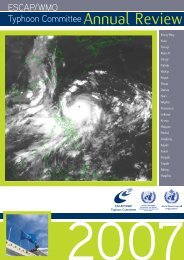TCAR - Typhoon Committee
TCAR - Typhoon Committee
TCAR - Typhoon Committee
You also want an ePaper? Increase the reach of your titles
YUMPU automatically turns print PDFs into web optimized ePapers that Google loves.
<strong>TCAR</strong><br />
CHAPTER 5 - RESEARCH FELLOWSHIP TECHNICAL REPORT<br />
the more intense the cyclone (x-axis), the larger<br />
are the initial EMI errors both in terms of wind and<br />
pressure (y-axis).The initial EMI minimum pressure is<br />
predominantly higher than the BT-analyzed minimum<br />
pressure for the whole range of TC intensities.For<br />
maximum wind, the EMI wind speeds in most cases<br />
are larger than the BT-analyzed values for TC of<br />
sub-typhoon strength, but are smaller than the BTanalyzed<br />
values for most typhoon cases.<br />
Fig. 2 - Initial errors of the ensemble mean intensity<br />
of the JMA EPS TC datasets in 2003-2005<br />
b. Forecast error<br />
Scatter diagrams of BT intensity changes and EMI<br />
intensity changes for all samples during 2003-2005<br />
are shown in Fig. 3.JMA EPS predictions demonstrate<br />
skills in forecasting the trend of TC intensity changes.<br />
Nevertheless, as shown by the bold line of linear<br />
regression against the perfect diagonal, the extent<br />
of changes has generally been under-predicted by<br />
the EPS, particularly for TC cases with significant<br />
weakening or intensification.<br />
(a) (b)<br />
Fig. 3 - Scatter diagram of BT intensity changes and<br />
EPS forecast intensity changes for all samples during<br />
2003-2005: (a) minimum pressure; (b) maximum<br />
wind.<br />
4. Calibration of deterministic forecasts<br />
If the initialization errors are corrected, the RMSE of<br />
EMW for 2005 at T+24, T+48, T+72, T+96, and T+120<br />
hour forecasts would become 16.5, 23.7, 27.9, 31.8, and<br />
32.4 kt respectively.As shown in Fig. 4(c), removing<br />
the initialization errors could reduce the EMW errors<br />
in the first 78 hours, whereas error reduction in EMP<br />
can be achieved all the way up to T+120 hour.<br />
To cater for the non-linearity of the forecast errors<br />
and the correlated nature of the two intensity<br />
parameters (minimum pressure and maximum wind<br />
speed), a commercially available statistical software<br />
with a radial basis function artificial neural network<br />
(ANN) (Broomhead and Lowe, 1988; Haykin, 1994)<br />
was used to devise a calibration mapping.Radial basis<br />
function networks consist of three layers: one for<br />
the inputs, one for the outputs, and a single hidden<br />
layer in between.Each unit in the hidden layer is<br />
represented by a radial basis function.The output<br />
units then complete the computation based on a<br />
weighted sum of results generated by all hidden units.<br />
The excellent approximation capabilities of radial<br />
basis function networks have been demonstrated by<br />
Park and Sandberg (1991), Poggio and Girosi (1990).<br />
In the construction of the ANN for TC intensity change,<br />
the following input parameters are used: (a) forecast<br />
hour; (b) initial BT minimum pressure; (c) initial BT<br />
maximum wind speed; (d) change of EMP during the<br />
forecast period concerned; and (e) change of EMW<br />
during the forecast period concerned.The BT initial<br />
intensity is used in order to remove the initialization<br />
errors.There are two output nodes in the ANN, namely<br />
BT-analysed change in minimum pressure and that in<br />
maximum wind speed.<br />
(a)(b)<br />
2009<br />
271

















